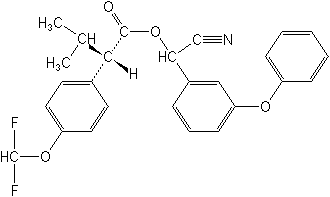|
Return to
Adverse
Effects
Abstracts
ACTIVITY:
Acaricide; Insecticide (pyrethroid)
CAS Name:
cyano(3-phenoxyphenyl)methyl (S)-4-(difluoromethoxy)-?-(1-methylethyl)benzeneacetate
Structure:

| Adverse
Effects:
Ataxia
Body
Weight Decrease
Bone
Brain
Cancer:
Potential for tumor promotion
Endocrine: Breast
Endocrine: Pituitary
Endocrine: Testicular
Endocrine: Uterus
G-Protein effect:
inhibits intercellular communication
Heart
Kidney
Liver
Lung
Sciatic Nerve
Spleen |
| Environmental
Effects:
Very
highly toxic to Fish, Insects, and Zooplankton |
Regulatory
Information
(only comprehensive for the US) |
| US
EPA Registered: |
No |
| US
EPA PC Code: |
118301 |
| California
Chemical Code |
2168 |
| US
Tolerances: |
Revoked |
| FDA
LMS Code: |
229 |
US
EPA Permit Date
and Registrant: |
1982,
American Cyanamid |
| Note: |
Banned
in Norway |
| European
Commission: |
Not
allowed to be used as an active ingredient after July 25, 2003. |
Registered
use in
(includes only a limited list of countries)
|
India,
Japan, Portugal |
| Japan's
Maximum Residue Levels (MRLs) |
Partial
list:
Apple, Artichoke, Barley, Beans (dry), Broad Beans, Broccoli,
Brussels Sprouts, Cabbage, Cauliflower, Cherry, Coffee beans,
Corn, Cotton seeds, Cucumber,Ginger, Grape, Grapefruit, Hop,
Horseradish, Kale, Lemon, Lime, Loquat, Natsudaidai, Onion,
Orange, Peach, Pear, Peas, Potato, Quince, Radish, Rape seeds,
Soybeans, Spinach, Taro, Tea, Tomato, Turnip, Watercress,
Wheat
--
Note the very high levels - 20
ppm - for Tea (Green, Black, Oolong, Wulung) |
| Other
Information |
| Molecular
Formula: |
C26H23
F2 NO4 |
| Manufacturers: |
DuPont,
BASF |
| Other
Names: |
AC
222, 705,
Aastar,
CL 222705,
Cybolt,
Cythrin,
Gurardian Pay-Off |
| Of
special interest: |
| PAN
BAD ACTOR (Acute Toxicity) |
| TOXNET
profile from Hazardous Substances Data Bank |
| Flucythrinate:
Material Safety Data Sheets & Labels |
| Abstracts |
| Highly
hazardous. WHO
Recommended Classification of Pesticides by Hazard and Guidelines
to Classification 2000-2002. Table
2. Highly hazardous (Class Ib) technical grade active ingredients
of pesticides, p 18 |
| November
26, 2002 - European
Commission: Flucythrinate is one
of 320 pesticides to be withdrawn in July 2003. "Some
320 substances used in plant protection products (PPPs) – including
insecticides, fungicides and herbicides – are to be withdrawn
from the market by 25 July 2003 as part of the European Commission’s
new approach to the evaluation of active substances in plant
protection products. This aims to improve safeguards to ensure
that all such products in use are safe for the environment and
human health. Users, wholesalers and retailers of plant protection
products will need to be aware of whether the products they
use or sell are likely to be withdrawn, so as to prevent them
being left with stocks of unusable material. Those concerned
should contact their national authority to check the authorisation
status for any particular product. The Regulation (n° 2076/2002
of 20 November 2002), with the list of the 320 substances, has
now been published in the Offical Journal. Ref: MIDDAY EXPRESS.
News from the Press and Communication Service's midday briefing. |
| September
2001 - Draft
Toxicological Profile for Pyrethrins and Pyrethroids. Organofluorine
pyrethroids discussed in the Profile include Flucythrinate
(Type 2),
US Department of Health
and Human Services. Public Health Service Agency for Toxic Substances
and Disease Registry. |
| June
14, 2001 -
Implementation of
the Community Strategy for Endocrine Disruptors - a
range of substances suspected of interfering with the hormone
systems of humans and wildlife. Communication from the Commission
to the Council and the European Parliament. Commission of the
European Communities, Brussels COM (2001) 262 final. (More information
available at: http://europa.eu.int/comm/environment/docum/01262_en.htm
|
| 1987
- Summary
of Toxicological Data for Flucythrinate. California
EPA, Department of Pesticide Regulation, Medical Toxicology
Branch. July 18, 1986 Revised August 12, 1987. |
| June
1993 -
Pesticide Information
Profile - Pesticide Management Education
Program at Cornell U |
| 1985
- World
Health Organization Review. |
| April
2000 -
Food and Drug Administration
Pesticide Residue Monitoring. - Table
3. Pesticides detectable by methods used in 1999 regulatory
monitoring. |
| March
12, 2001 -
EC: Maximum Residue Level
(MRL) in Tea is 0.1 ppm. Page 400.
|
| 1993
- Evaluation
(152) by FAO (Food and Agriculture Organization of the U.N. |
| October
2001 -
Glossary of Pesticide Chemicals.
A listing of pesticides subject to analysis
of residues in foods and feeds by the US Food and Drug Administration. |
| US
Federal Register |
| Date
Published |
Docket
Identification Number |
Details |
| Sept
27, 1995 |
OPP-300328A |
Revocation
of Tolerances. FINAL RULE. The proposal
to revoke the tolerances was published in the Federal Register
of April 14, 1994 (59 FR 17754). EPA initiated this action because
all registered uses of these pesticide chemicals in or on raw
agricultural commodities and processed foods and feeds have
been canceled. The registrations for these pesticide chemicals
were canceled because the registrant failed to pay the required
maintenance fee, or the registrant voluntarily canceled all
registered uses of the pesticide. The sections of CFR are:
Sec. 180.400
Sec. 185.3300
Sec. 186.3300 |
|